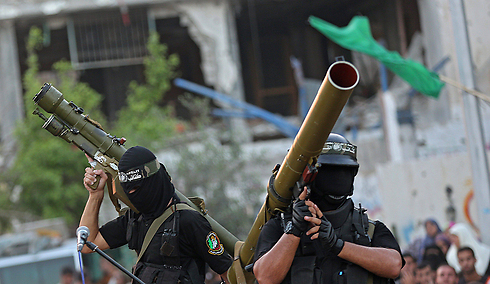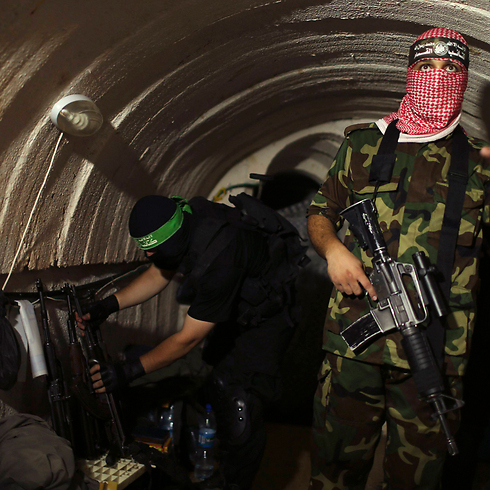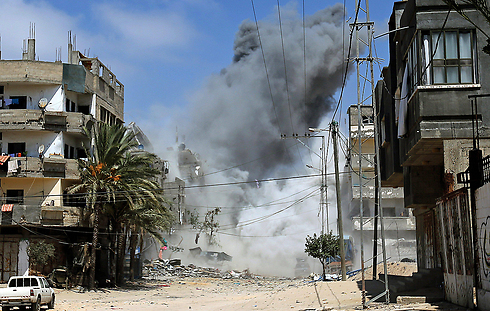Judge us by what we say not what we do
Reports from Ynet and Times of Israel. The photos and captions reproduced are the ones that were published in the two articles.

Destruction caused to commercial building in Rafah after IAF attack Photo by Reuters.
Israel’s Protective Edge report: 44% of Palestinian casualties were terrorists
Government-sanctioned report is released as ‘pre-emptive strike’ ahead of international UN report due to come out this month; authors say report provides evidence to justify Israel’s decision to launch war in Gaza based on international law.
By Itamar Eichner, Ynet news
June 14, 2015
At least 44 percent of the 2,125 Palestinians killed during Operation Protective Edge in Gaza last summer were identified by the IDF as armed fighters belonging to Hamas or other terror organizations in the Strip, according to an Israeli report released Sunday.
The Foreign Ministry’s report presents Israel’s diplomatic, military and legal positions on the events of Protective Edge, ahead of the release of a UN committee’s report on Monday.
The international report will only be presented to the UN Human Rights Council in Geneva on June 29, but the two warring sides, as well the members of the UN Security Council, will receive a copy of it this week.
The 277-page report, which cited Israel’s internal probes and statements from Western leaders backing its right to self-defense, suggested the Netanyahu government hoped to defuse criticism from the UN Human Rights Council (HRC) inquiry in advance.
Deeming the HRC biased, Israel boycotted its investigators as it did those from the council who looked into its 2008-09 Gaza offensive. That HRC inquiry was harshly critical of both Israel and Hamas.
But this time around, the stakes are higher. The Palestinians have joined the International Criminal Court and are pursuing war crimes charges against Israel. The council’s new report, expected as soon as this week, could play a key role in the case against Israel.
“Having on the record our view of this war is extremely important, and we have nothing to hide,” Dore Gold, the new director of Israel’s Foreign Ministry, told reporters at a special briefing held to unveil Israel’s own investigation into the war.
Gold was accompanied by the country’s Deputy Foreign Minister, Tzipi Hotovely, and governmental and military legal experts who worked on the report.
Palestinians have said that the IDF violated the rules of war, which include giving adequate warning to civilians, using proportionate force and distinguishing between civilians and combatants. They have pointed to the high civilian casualty count as evidence.
In Sunday’s report, Israel defended itself with the same arguments it has been making since the fighting ended, albeit with a level of detail never shown before.


Top, Hamas fighters in military parade in Gaza, photo EPA, below Hamas terrorists in one of the tunnels, photo, Reuters, both photos undated.
According to Israel, the actions of Hamas and other terror groups in the Strip that are detailed in the report constitute as war crimes, crimes against humanity, and a blatant violation of international law.
UN numbers of casualties in Gaza differ from Israel’s, stating 2,256 Palestinians, including 1,563 civilians, were killed in the 50-day conflict.
The report disputes the UN figures, saying confirmed non-combatants made up 36 percent of the Palestinian dead and many militants were misidentified as civilians.
“Harm to the civilian population also occurred as the result of unfortunate – yet lawful – incidental effects of legitimate military action in the vicinity of civilians and their surroundings, and as a result of the inescapable constraint of commanders not being infallible, intelligence not being perfect and technological systems sometimes failing,” the report says.


Top, IDF bombardment in Shati refugee camp, photo by EPA, below, destruction caused to building in Gaza hit in IAF attack, photo by AFP.
The Palestinians rejected the Israeli report. “The Israeli decision to deny targeting civilians in Gaza is the logical continuation of what Israel did in Gaza,” Ehab Bseiso, spokesman of the Palestinian unity government told AFP. Therefore, the report published on Sunday “does not change our position to demand an international investigation,” he said.
Hamas spokesman Sami Abu Zuhri, meanwhile, called the Israeli report worthless, saying “Israeli war crimes are clear because they were committed in front of live cameras”. Hamas has denied any wrongdoing, saying it acted to protect Palestinians.
Izzat Risheq, a senior Hamas official, called the report a “lie promoted by the occupation to cover up its crimes.” He said “the hand of justice will reach the perpetrators.”
Hamas’ war crimes
The Israeli report presents a list of war crimes committed by Hamas and the other terror organizations in the Gaza Strip and includes testimony and seized Hamas documents which prove, according to Israel, that Hamas’ strategy was to encourage its fighters to move in civilian areas, knowing that it would constrain Israel’s ability to act and turn the civilian population there into a human shield.
The report includes what Israel says are seized Hamas documents encouraging its fighters to move in civilian areas, knowing that it would constrain Israel’s ability to act.
“We were a bit struck and surprised with the amount of documentation that we managed to recover during the operation actually indicating that this is a strategy of Hamas,” said Eran Shamir-Borer, a lawyer in the Israeli military’s international law department.
It also lists the locations of military command centres operating from civilian structures, mosques used as firing posts for snipers, schools used to store weapons and rockets, explosives planted in civilian structures and tunnels dug from inside civilian structures and residential areas.
The report also includes examples of instances in which Hamas forced civilians to arrive in fighting zones and stay there, and instructed them to ignore IDF warnings given before attacks on targets in those areas.
The Israeli report further details several instances in which the Palestinian militants posed as civilians or as IDF soldiers.
Also detailed are the main events that led to the launch of Operation Protective Edge, Israel’s main objectives, the terror targets the IDF acted against, the humanitarian aid Israel allowed into the Gaza Strip, the damage caused to the Israeli civilian population, Israel’s inspection and investigation mechanisms, and more.
“From 2000, Hamas’ terror activity has led to the death of at least 1,265 Israelis; Hamas fired over 15,200 rockets and mortars at Israeli citizens (4,500 of which during Protective Edge), covering some 70 percent of Israel’s population; Hamas dug at least 32 tunnels which cross the border between Gaza and Israel, meant to commit terror attacks against Israeli population centres,” the report states.
Therefore, “Israel’s decision to launch a large-scale military operation against Hamas and other terror groups in the Gaza Strip as part of the ongoing armed conflict these organizations led was justified according to international law.”
The report also details Israel’s humanitarian efforts to send medical equipment, food and other supplies into the Gaza Strip during the fighting, despite the fact Hamas and the other terror groups were attacking the border crossings while supply was being let through.
With regards to the proposals for ceasefire, the report states that “had Hamas accepted the first Egyptian-mediated ceasefire, the one Israel accepted on July 15 that had the same conditions as the ones Hamas eventually accepted on August 26, 90 percent of casualties could have been prevented.”
According to the report’s authors, the information collected focused on facts, data and the legal aspects of the fighting against Hamas and the other terror factions in the summer of 2014.
Israel has been working on the report for several months and its authors says the report proves that Israel followed international law and made great efforts to avoid hurting innocent people, whether by using the “Knock on the Roof” procedure or by dropping leaflets, phone calls, radio broadcasts and warning strikes with unarmed shells ahead of live airstrikes.
Shamir-Borer showed reporters what he said was a declassified “target card” that laid out the calculations Israel took before striking a suspected arms cache hidden in the home of an Islamic Jihad leader in southern Gaza.
The “operational directives” listed on the card call for destroying the arms while avoiding civilian casualties. It calls for a single airstrike on the home, at night and only after warning people to leave, and “real-time surveillance” to be on the lookout for civilians.
Shamir-Borer said the home was hit, and there was a “secondary blast,” indicating weapons were stored there. The report said the army was unaware of any casualties from the strike. Shamir-Borer said the army went through a similar process in all 5,000 preplanned airstrikes carried out during the fighting.
The report calls to examine the incidents in which civilians were hurt in Gaza must be against the backdrop of the war crimes committed by Hamas and its use of civilian population, alongside Israeli effort to prevent harming civilians and adhere to international law.
Israel, the report says, did not intentionally act to cause damage to the civilian Palestinian population and its surroundings during the confrontation, and deeply regrets this damage.
Prime Minister Benjamin Netanyahu said the Israeli report was meant to be a pre-emptive strike, noting that “this report is especially important because the State of Israel is under an unprecedented de-legitimization attack. This attack is not relevant, it’s political. Its goal is to tarnish the State of Israel, and we intend to respond to this attack… We will act wherever we need to for as long as we need to in order to deal with false claims and anti-Israeli initiatives.”
The Associated Press and Reuters contributed to this report.
The 2014 Gaza Conflict: Factual and legal aspects. Ministry of Foreign Affairs, May 2015 pdf file, 244 pp plus 11 page Annex.

Weapons found inside a tunnel near Kibbutz Sufa on the Israel-Gaza border on July 17, 2014. Photo from IDF Spokesperson’s Office/Flash90
Israel shifts to offence ahead of UN report on Gaza war
The Israeli examination of Operation Protective Edge is thorough and often persuasive but also carries traces of advocacy
By Mitch Ginsburg, military correspondent, Times of Israel
June 15, 2015
There are, as some have noted, two ways to look at the Israeli-Palestinian conflict. A narrow lens, focused on 10,000 square miles or so of the West Bank and Israel, shows a military power controlling a largely unarmed entity in occupied territory. A wider lens reveals a tiny minority of Jews – one of the Middle East’s only thriving minorities – clinging to a thread of land along the Mediterranean coast.
To a certain extent this is the difference between the imminent UN-commissioned report on the summer’s 50-day war in Gaza and the Israeli review released on Sunday: One will likely focus on the hundreds of Palestinian deaths, including the tragic deaths of nearly 500 children, and assert that war crimes were committed; the other acknowledges the deaths but seeks to put them in the larger framework of an enemy that targets civilians and operates from among its own people and an army that goes to some lengths to try and limit the deaths of innocents.
The 250-page Israeli report, to be sure, is braided with several strands of Israel advocacy, an attempt to defend against allegations with the army’s time-honoured tactic of offence providing the best defense. For example, among the dozens of pages addressing the legal infrastructure of the IDF MAG Corps and the Attorney General and the High Court of Justice, there is but brief mention of the fact that, despite the efficiency and openness of the system, not one Israeli soldier has been charged with wrongful death or any crime more severe than looting; nor is there a clear recommendation to change any army procedures.
The central argument, though, is coherent and persuasive and evidence of the fact that Israel has understood that war is increasingly fought in the sphere of public opinion and that there, too, Israel must strive for clarity. Ironically, an offshoot of this realization is that as the calls for external scrutiny rise, the thirst for rigorous domestic investigation subsides. This helped bury the notion of a joint Israeli and international commission of inquiry and played a role in the sinking of the Knesset Foreign Affairs and Defense Committee inquiry, both of which would have lent credibility to the bulk of Israel’s claims.
The report opens with a description of Hamas and its ideology – ” “[t]here is no war going on anywhere, without [the Jews’] finger in it” – and asserts that Israel, searching for three abducted Israeli teenagers (later found dead) in June 2014, “tried to avoid escalation in the Gaza Strip.” It does not dwell on the 10 Israeli brigades sent to operate in the West Bank and the combustible dismantling of Hamas infrastructure there – a move taken in light of the kidnapping and with the then-classified knowledge that Hamas intended to unseat the PA in the West Bank through a series of orchestrated terror attacks.
Instead the report states that despite Israel’s diplomatic efforts to curb escalation, Hamas and other terror organizations continued to fire mortars and rockets at Israeli civilians and, when the organization on July 7 fired more than 60 projectiles at Israel, the government was “left with no choice” but to launch an aerial offensive.
“No government would have failed to respond to such an unceasing barrage of attacks on its citizens,” the authors of the report wrote.
The many dozen pages cataloguing Hamas’s violations of the laws of armed conflict provide specifics about the known nature of the war. The al-Tawheed mosque in Khuza’a and the Sheikh Hasnain mosque in Shejaiya were used as weapon storage depots and command posts; other mosque minarets were used as sniper nests. Al-Wafa hospital in Shejaiya “was transformed into a sniper post, an anti-tank missile launch site, a weapons storage facility, a platform for operational surveillance devices, and a cover for tunnel infrastructure.” Schools and UN facilities were repeatedly used as cover to enable nearby rocket launches.

A Palestinian man kisses an Izz ad-Din Al-Qassam sniper over the debris of destroyed houses in Shejaiyah, neighbourhood of Gaza City, in the northern Gaza Strip, August 27, 2014 Photo by Abed Rahim Khatib/Flash90
Embedding military operations within the civilian environment, the report notes,
is not ancillary to their main military objectives; nor is it an inevitability of combat within the Gaza Strip. Rather, it is a deliberate and systematic strategy designed to draw IDF forces into combat inside densely populated areas where civilian casualties and damage will be blamed on Israel and produce international sympathy for Hamas.
The report also predominantly takes a bird’s eye view of the army’s response to this combat doctrine, explaining how Israel adhered throughout to the principles of distinction – discerning between enemies and innocents – and proportionality – which demands that a party launching a strike on a specific target ensure that the expected collateral damage not “be excessive in relation to the concrete and direct military advantage anticipated.”
This means that an attack against a low-value military target that is expected to result in 100 civilian fatalities, the authors explain, “would be considered disproportionate, whereas one hundred attacks against military objectives of the same value that are expected to each result in one fatality per strike is likely to be regarded as proportionate.”
There is also careful documentation of the goods ferried from Israel to Gaza during the war – 5,637 trucks carrying 122,575 tons of supplies – and the efforts made to warn the public to leave anticipated combat zones.
Finally, the Israeli government report seeks, nearly a year after the war, to shed light on the matter of civilian deaths. Not only does it make the long-absent claim that of the 2,125 Palestinians killed during the war, 936, or 44 percent, were militants, but also that the numbers so often quoted during the war – generally that some 1,500 civilians had been killed by Israeli troops – were purposely skewed by Hamas.
On July 11, the Hamas-controlled Interior Ministry in Gaza uploaded “guidelines” to its website:
Anyone killed or martyred is to be called a civilian from the Gaza Strip or Palestine, before we talk about his status in jihad or his military rank. Don’t forget to always add “innocent civilian” or innocent citizen in your description of those killed in Israeli attacks on the Gaza Strip…. Do not publish photos of military commanders. Do not mention their names in public, and do not praise their achievements in conversations with foreign friends.
Taking the wide-angle view, the report notes, too, that after Operation Cast Lead in 2008-9, Abu Obeida, spokesman for Hamas’s Izz al-Din al-Qassam Brigades, claimed that only 48 of its members were among the over 1,100 dead. Later that number was radically altered by a different Hamas spokesman. “Not coincidentally,” the report notes, that admission “came only after the Goldstone Report was published.”
